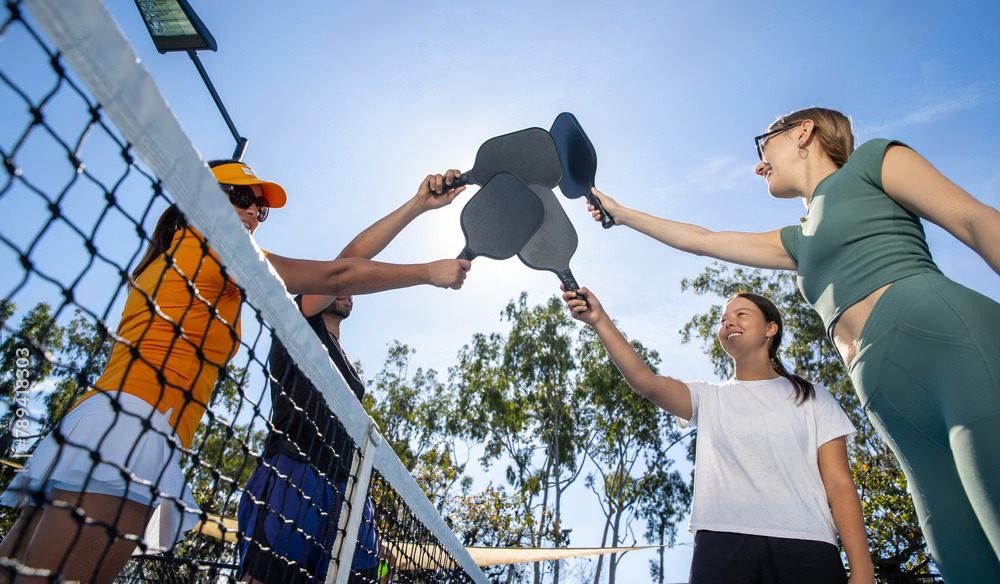Choosing the right pickleball paddle can make a huge difference in how you play. Whether you’re a beginner learning consistency, an intermediate player refining your control, or an advanced competitor chasing spin and power, the right paddle helps you play to your strengths.
Below we break down the four most important factors to consider:
- Paddle Surface Material
- Paddle Thickness
- Paddle Core
- Paddle Shape
1. Paddle Surface Material
Fiberglass (Composite)
- Characteristics: Softer face, more flex, generates extra “pop” off the ball.
- Best for: Beginners and intermediate players who want easy power and a lively feel.
Carbon Fiber (T700/T800, Raw Carbon)
- Characteristics: Stiff, durable, excellent control and spin potential.
- Best for: Intermediate and advanced players seeking consistency, precision, and spin.
Graphite
- Characteristics: Lightweight, offers a blend of control and quick reactions at the net.
- Best for: Players who value speed and maneuverability, such as doubles specialists.
Rule of Thumb: Fiberglass = power, Carbon Fiber = control & spin, Graphite = speed.
2. Paddle Thickness
Thin (13–14mm)
- Characteristics: Lighter, more “pop” and responsiveness, smaller sweet spot.
- Best for: Power hitters, singles players, or anyone who likes fast reaction shots.
Mid (15–16mm)
- Characteristics: Balanced feel, blend of control and power.
- Best for: Most recreational to competitive players.
Thick (17–19mm)
- Characteristics: Softer feel, better touch and control, absorbs vibration, large sweet spot.
- Best for: Control-oriented players, defensive style, or those with wrist/elbow concerns.
3. Paddle Core
Polypropylene (PP) Honeycomb
- Characteristics: Quiet, durable, widely used, balanced performance.
- Best for: All-around players, doubles, and communities with noise restrictions.
Nomex Honeycomb
- Characteristics: Hard, loud, explosive power.
- Best for: Singles players and those who prioritize speed and power.
Aluminum Honeycomb
- Characteristics: Control-oriented, softer, lightweight.
- Best for: Players who value touch and finesse over power.
Modern Trend: PP honeycomb dominates the market thanks to balance and durability, but EVA foam hybrids are emerging for softer feel and shock absorption.
4. Paddle Shape
Standard (16” x 8”)
- Characteristics: Balanced reach, control, and sweet spot size.
- Best for: Beginners to advanced — the most versatile shape.
Elongated (16.5”+ length, narrower width)
- Characteristics: More reach, more power, slightly smaller sweet spot.
- Best for: Singles players and aggressive attackers.
Wide Body
- Characteristics: Larger surface area, bigger sweet spot, less reach.
- Best for: Beginners or control players who want forgiveness on off-center hits.
Matching Paddle Types to Player Styles
| Player Style / Level | Recommended Paddle Build | Why |
|---|---|---|
| Beginner | Fiberglass face + 14–16mm PP core, wide body | Easier power, larger sweet spot, forgiving |
| Intermediate | T700 carbon fiber face + 16mm PP core | Balanced control, spin, and stability |
| Advanced/Pro | Raw carbon fiber face + 19mm hybrid core (PP + EVA/Kevlar) | Maximum control, precision, and spin |
| Power Hitter | Thin (13mm) core + fiberglass or Nomex | More “pop” and speed off the face |
| Control Specialist | Thick (17–19mm) core + carbon fiber | Softer feel, touch shots, consistent blocks |
| Singles Player | Elongated paddle + Nomex/PP | Extra reach and explosive shots |
| Doubles Player | Standard paddle + PP/EVA hybrid | Control, consistency, softer hand feel |
Final Takeaway
There’s no “one-size-fits-all” pickleball paddle. The right choice depends on your skill level, playing style, and preferences for power vs. control. At SwiveGear, we design and manufacture paddles across all these categories — helping both brands and players find their perfect fit.

